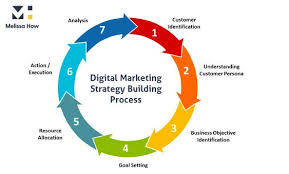The Importance of a Strong Digital Advertising Strategy
In today’s digital age, having a robust digital advertising strategy is essential for businesses looking to reach and engage with their target audience effectively. With the vast amount of time people spend online, digital advertising presents a unique opportunity to connect with potential customers in a personalized and impactful way.
Key Components of a Successful Digital Advertising Strategy
**Target Audience:** Understanding your target audience is crucial for crafting relevant and engaging digital ads. By defining your audience demographics, interests, and online behavior, you can tailor your ads to resonate with them.
**Clear Objectives:** Clearly defined goals are essential for measuring the success of your digital advertising campaigns. Whether it’s increasing brand awareness, driving website traffic, or generating leads, setting specific objectives will guide your strategy.
**Platform Selection:** Choosing the right digital advertising platforms based on where your target audience spends their time online is key. Platforms like Google Ads, Facebook Ads, Instagram, and LinkedIn offer diverse targeting options to reach specific audiences.
**Compelling Creatives:** Creative elements such as ad copy, images, and videos play a significant role in capturing users’ attention and driving engagement. High-quality creatives that align with your brand messaging are essential for effective digital ads.
Benefits of an Effective Digital Advertising Strategy
An effective digital advertising strategy can yield numerous benefits for businesses:
- Increased brand visibility and awareness
- Precise targeting to reach the right audience
- Measurable results for tracking ROI
- Enhanced customer engagement and interaction
- Improved lead generation and conversion rates
- Competitive advantage in the digital landscape
In Conclusion
A well-crafted digital advertising strategy is a powerful tool for businesses seeking to elevate their online presence and drive meaningful results. By leveraging data-driven insights, creative content, and strategic planning, businesses can create impactful campaigns that resonate with their target audience and drive business growth in the digital realm.
Key Concepts and Strategies in Digital Advertising: FAQs on Steps, C’s, P’s, and More
- What are the 4 steps of digital advertising?
- What are the 7 C’s of digital marketing?
- What are the 5 strategies of advertising?
- What are the 5 P’s of digital marketing?
- What are the 4 advertising strategies?
- What are the 8 digital marketing strategies?
- What are the four digital marketing strategies?
What are the 4 steps of digital advertising?
When it comes to digital advertising strategy, understanding the four key steps is essential for creating successful campaigns. The first step involves defining clear objectives and goals that align with your overall marketing strategy. Next, identifying and understanding your target audience is crucial for crafting personalized and engaging ads. Choosing the right digital advertising platforms based on where your audience is most active comes as the third step. Lastly, measuring and analyzing the performance of your campaigns allows for optimization and continuous improvement to drive better results. By following these four steps diligently, businesses can develop effective digital advertising strategies that resonate with their audience and achieve desired outcomes.
What are the 7 C’s of digital marketing?
The 7 C’s of digital marketing are a set of principles that serve as a framework for developing a successful digital advertising strategy. These 7 C’s include: Content, Context, Clarity, Consistency, Creativity, Channels, and Customization. Each C represents a key aspect of digital marketing that businesses should focus on to effectively engage with their target audience, drive brand awareness, and achieve marketing objectives. By incorporating these principles into their digital advertising strategy, businesses can create impactful campaigns that resonate with consumers and deliver measurable results in the online landscape.
What are the 5 strategies of advertising?
When it comes to digital advertising strategy, there are five key strategies that businesses can leverage to maximize their impact and reach. These strategies include defining a clear target audience to tailor ads effectively, setting specific objectives to measure success, selecting the right platforms based on audience behavior, creating compelling creatives to capture attention, and continuously optimizing campaigns for improved performance. By implementing these five essential strategies, businesses can enhance their online presence, engage with their target audience more effectively, and achieve their advertising goals in the digital landscape.
What are the 5 P’s of digital marketing?
The 5 P’s of digital marketing refer to the essential elements that businesses must consider when developing a comprehensive digital advertising strategy. These 5 P’s include Product, Price, Place, Promotion, and People. Product focuses on understanding and refining the products or services being offered to meet the needs of the target audience. Price involves determining competitive pricing strategies that align with market demands. Place refers to selecting the right channels and platforms to reach the target audience effectively. Promotion involves creating compelling content and advertisements to promote products or services. Lastly, People emphasize understanding and connecting with the target audience to build strong relationships and drive engagement in digital marketing efforts. By incorporating these 5 P’s into their strategy, businesses can create a well-rounded approach that maximizes their digital marketing efforts for success.
What are the 4 advertising strategies?
In the realm of digital advertising strategy, businesses often inquire about the fundamental advertising strategies that can drive success in their campaigns. The four core advertising strategies encompass a range of approaches to reach and engage target audiences effectively. These strategies typically include display advertising, search engine marketing (SEM), social media advertising, and email marketing. Display advertising involves visually appealing ads placed on websites to increase brand visibility. SEM focuses on optimizing search engine results to drive traffic and conversions. Social media advertising leverages platforms like Facebook and Instagram to target specific demographics. Email marketing utilizes personalized emails to nurture leads and foster customer relationships. By incorporating these diverse strategies into their digital marketing efforts, businesses can enhance their online presence and achieve their advertising goals efficiently.
What are the 8 digital marketing strategies?
When it comes to digital marketing strategies, there are various approaches that businesses can leverage to achieve their goals effectively. Some of the key digital marketing strategies include search engine optimization (SEO) to improve organic visibility, pay-per-click (PPC) advertising for targeted reach, content marketing to engage and inform audiences, social media marketing for building brand presence, email marketing for personalized communication, influencer marketing to reach niche audiences, affiliate marketing for partnerships and referrals, and video marketing for engaging visual content. Each of these strategies plays a unique role in a comprehensive digital marketing plan tailored to meet specific business objectives and connect with the target audience in meaningful ways.
What are the four digital marketing strategies?
When it comes to digital marketing strategies, there are four key approaches that businesses often leverage to achieve their goals effectively. These strategies include search engine optimization (SEO), social media marketing, content marketing, and email marketing. SEO focuses on optimizing a website to increase its visibility in search engine results. Social media marketing involves using social platforms to engage with audiences and promote products or services. Content marketing entails creating valuable and relevant content to attract and retain customers. Email marketing involves sending targeted messages to leads and customers to nurture relationships and drive conversions. By incorporating these four strategies into a cohesive digital marketing plan, businesses can enhance their online presence and engage with their target audience in meaningful ways.



